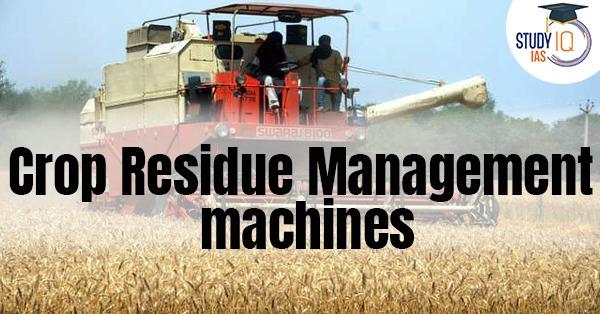Table of Contents
Crop Residue Management Machines: Background
- To contain the problem of stubble burning in the State, Punjab Government has launched a scheme on Promotion of Agricultural Mechanization for In-situ Crop Residue Management.
- Paddy stubble burning is mainly practiced in Indo-Gangetic plains of the States of Punjab, Haryana and Uttar Pradesh to clear the fields for Rabi crop sowing but it can be minimize by Crop Residue Management.
- Crop Residue Management scheme, the state government has aggressively promoted two stubble management machines i.e. Happy Seeder and Super SMS (Straw Management System).

Crop Residue Management Machines: Current Situation
- Crop Residue Management Rejected by the farmers: At present, Punjab has 13,540 Happy Seeders and 5,972 Super SMS attached Combine harvesters, but farmers have neglected both these crop residue management (CRM) machines.
- According to the law, no combine harvesters can be run in the fields without Super SMS attachment.
- Obsolete machinery: Punjab has around 18,000 combine harvesters out of which nearly 50% are suitable for the attachment of Super SMS because some are quite old. The state could not get Super SMS attached to even these 50% harvesters in the past four years.
- Alternative machinery: The usage of Super SMS fitted combines is also very limited now because several farmers prefer to burn their straw, and few others prefer a collection of straw through a bailer machine, which cuts stubble close to the roots.
- While remaining use other alternatives like paddy straw chopper, mulcher, Rotary slasher, cutter and spreader etc.
Crop Residue Management: Working of machines
| Super SMS (Straw Management System) | Happy Seeder (HS) | Super Seeder |
|
|
|

The Significance of Happy Seeder for the current Paddy Harvesting Season in Punjab
- For wider coverage: The current available numbers of Super Seeders (SS) could cover only 60% the rice area in the state. So, Happy Seeders will have to be utilized along with SS, as the entire rice area is to be covered in a small window of paddy harvesting and wheat sowing.
- Lower input costs: To employ a Happy Seeder on farm fields, it costs almost 50% less for a farmer as compared to a Super Seeder.
- Higher yields with Happy Seeder: Due to high temperatures, the wheat yield came down to 13-14 quintals from an average of 20-21 quintals per acre but, the farmers who had sown wheat with Happy Seeder reported less loss of yield.
- Advantage of Super Seeder over Happy Seeder: With Happy Seeder, stubble of paddy remains in the field for a long time even after growing of the wheat crop but with Super Seeder stubble is buried under the earth and fields looks clean.





















 WhatsApp
WhatsApp